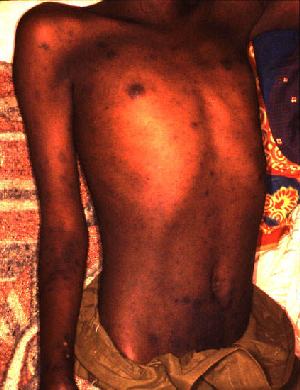Epidemic typhus
| Typhus | |
|---|---|
 |
|
| Rash caused by epidemic typhus | |
| Classification and external resources | |
| Specialty | infectious disease |
| ICD-10 | A75.1 |
| ICD-9-CM | 080-083 |
| DiseasesDB | 29240 |
| MedlinePlus | 001363 |
| eMedicine | med/2332 |
| MeSH | D014438 |
Epidemic typhus (also called "camp fever", "jail fever", "hospital fever", "ship fever", "famine fever", "putrid fever", "petechial fever", "Epidemic louse-borne typhus," and "louse-borne typhus") is a form of typhus so named because the disease often causes epidemics following wars and natural disasters. The causative organism is Rickettsia prowazekii, transmitted by the human body louse (Pediculus humanus humanus).
Symptoms include severe headache, a sustained high fever, cough, rash, severe muscle pain, chills, falling blood pressure, stupor, sensitivity to light, delirium and death. A rash begins on the chest about five days after the fever appears, and spreads to the trunk and extremities. A symptom common to all forms of typhus is a fever which may reach 39 °C (102 °F).
Brill-Zinsser disease, first described by Nathan Brill in 1913 at Mount Sinai Hospital in New York City, is a mild form of epidemic typhus which recurs in someone after a long period of latency (similar to the relationship between chickenpox and shingles). This recurrence often occurs in times of relative immunosuppression, which is often in the context of malnutrition and other illnesses. In combination with poor sanitation and hygiene which leads to a greater density of lice, this reactivation is why typhus forms epidemics in times of social chaos and upheaval.
Feeding on a human who carries the bacterium infects the louse. R. prowazekii grows in the louse's gut and is excreted in its feces. The disease is then transmitted to an uninfected human who scratches the louse bite (which itches) and rubs the feces into the wound. The incubation period is one to two weeks. R. prowazekii can remain viable and virulent in the dried louse feces for many days. Typhus will eventually kill the louse, though the disease will remain viable for many weeks in the dead louse.
...
Wikipedia
